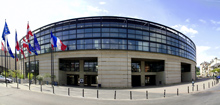ITS frequently intervenes, e.g. in terms of studies, in the context of projects in the field of architectural acoustics, which aims at providing spaces in which the auditory comfort of the occupants is taken into account as a fundamental component of the quality of many buildings.
As their reason for being is to offer optimal conditions for speech, singing and / or music, performance halls, e.g. theaters, concert halls and screening rooms, cabarets, operas, auditoriums, but also dance halls and discotheques are often the object of studies in the context of projects of architectural acoustics (when they are not bars or pubs, which are periodically concerned too), for what the expertise of the human resources of ITS in this field is based on initial training as an acoustician and on a multi-decade practice.
|
ITS frequently intervenes in the field of architectural acoustics |
Limitation of the sound transmission
The limitation of the sound transmission is often an important problem to consider inside such buildings for which an architect intervenes e.g. in the case of adjacent projection rooms (so as to keep to each room the soundscape specific to a film that the viewer has chosen, without the sound pollution that would be related to the diffusion of another soundtrack in a neighboring room) or vis-à-vis the outside e.g. in the case of the noise limitation of establishments broadcasting amplified music.
In terms of studies in the context of such projects, ITS can perform predictive acoustic calculations to assess the sound reduction index of partitions.
Reverberation control
The reverberation control of such premises is always a major issue of a project when it comes to optimizing, by appropraite studies, the acoustic environment resulting from the presence of one or more sound source(s), the conditions of propagation of sounds and listeners.
The reverberation time (duration) is often a fundamental indicator of their acoustic quality (when it comes to premises for music, for conferences or teaching or to sports halls) and is therefore limited according to the destination of the space i.e. according to the activities that take place there (in relation with word, song and music, instrumental or not).
For spaces with the most demanding acoustics requirements, more specific performance indicators are used e.g. 50 or 80 ms (C50, C80) clarity, early decay time EDT (Early Decay Time), STI speech transmission index, central time TS , definition D50, sound strength G, lateral efficiency (LF and LFC).
Regarding the limitation of sound transmission and the reverberation control, ITS has computational means for predicting those performance indicators for architectural acoustics of such spaces.
For other premises, taking into account the more or less specific noise limitation and acoustic comfort requirements related to the occupants' length of stay and their activities, the ratio of the equivalent absorption area to the volume may be the subject of a project specification (e.g. with reference to a non-mandatory application standard) in relation to the group of spaces to be considered (according to the classification of this standard).
ITS can carry out an engineering mission in architectural acoustics for varired premises, such as mentioned above.
Decrease in the noise level
The decrease in the noise level by doubling the distance to the source (spatial sound decay rate) may in some cases be a relevant indicator of the acoustic quality of premises such as offices (individual, collective, or open spaces) and associated spaces (meeting rooms, relaxation areas, restaurants) or other work areas such as workshops and production halls; ; sometimes these are premises in the design of which an architect has not always been involved (especially if they are very old), and the involvement of an architect is not always a guarantee of perfect acoustic, anyway.
In terms of studies in the context of projects, ITS can also use its prediction tools for architectural acoustics for such premises, in order to verify their compliance with the reference texts, and if necessary, to develop technical solutions allowing their habitability to be improved with respect to all the considerations related to soundproofing.
Equipment noise and exterior noise
The limitation of noise from equipment e.g. Heating Ventilation Air Conditioning (HVAC) facilities, involving proper consideration of the acoustic characteristics of equipment, and external noise (transport and other human activities) is not unrelated to architectural acoustics.
In this field, in terms of studies in the frame of projects, ITS can also perform calculations, acoustic measurements (e.g. noise levels).
Thus, in terms of architectural acoustics, ITS carries out studies in the context of projects in relation to the performance and quality indicators of sound comfort:
- predictions using simulation tools
- on-site measurements before or after carrying-out works
- clarification of objectives and technical recommendations to achieve them
Such studies of architectural acoustics (in aid of the building owner, the constructor or an installer - including for the implementation of noise reduction solutions -) requiring an extended expertise, are oriented, in the context of projects, towards the definition of constructive provisions (construction of walls, floors and ceilings/roofs with high acoustic performance, positioning of linings absorbing sound waves, fitting of screens and noise barriers, construction of enclosures for noisy equipment, installation of silencers) likely to prevent non-conformities in terms of acoustics and/or to remedy the weaknesses of existing constructions in terms of soundproofing, for what the specialized human resource composing ITS engineering office has a long and diversified experience.
This counts towards getting choice soundscapes, everywhere (what is the slogan of ITS).
